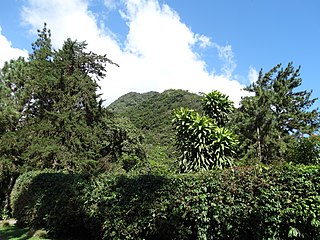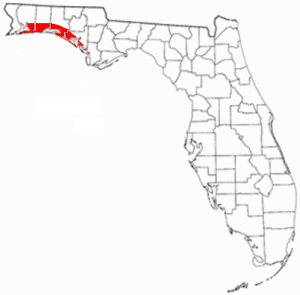Related Research Articles

Central America is a subregion of North America. Its political boundaries are defined as bordering the United States and the Gulf of Mexico to the north, Colombia to the southeast, the Caribbean Sea and the Gulf of Mexico to the east, and the Pacific Ocean to the southwest. Central America is usually defined as consisting of eight countries: Belize, Costa Rica, El Salvador, Guatemala, Honduras, Nicaragua, Mexico, and Panama. Within Central America is the Mesoamerican biodiversity hotspot, which extends from southern Mexico to southeastern Panama. Due to the presence of several active geologic faults and the Central America Volcanic Arc, there is a high amount of seismic activity in the region, such as volcanic eruptions and earthquakes, which has resulted in death, injury, and property damage.

Panama, officially the Republic of Panama, is a country in Latin America at the southern end of Central America, bordering South America. It is bordered by Costa Rica to the west, Colombia to the southeast, the Caribbean Sea to the north, and the Pacific Ocean to the south. Its capital and largest city is Panama City, whose metropolitan area is home to nearly half of the country's over 4 million inhabitants.

The Panama Canal is an artificial 82-kilometre (51-mile) waterway in Panama that connects the Atlantic Ocean with the Pacific Ocean, cutting across the Isthmus of Panama, and is a conduit for maritime trade. Locks at each end lift ships up to Gatun Lake, an artificial fresh water lake 26 meters (85 ft) above sea level, created by damming up the Chagres River and Lake Alajuela to reduce the amount of excavation work required for the canal. Locks then lower the ships at the other end. An average of 200,000,000 L (52,000,000 US gal) of fresh water is used in a single passing of a ship. The canal is threatened by low water levels during droughts.

Panama City, also known as Panama, is the capital and largest city of Panama. It has a total population of 1,086,990, with over 2,100,000 in its urban area. The city is located at the Pacific entrance of the Panama Canal, in the province of Panama. The city is the political and administrative center of the country, as well as a hub for banking and commerce.

Bay County is a county on the Emerald Coast in Northwest Florida. As of the 2020 census, the population was 175,216. Its county seat is Panama City.

Panama City is a city in and the county seat of Bay County, Florida, United States. Located along U.S. Highway 98 (US 98), it is the largest city between Tallahassee and Pensacola. It is also the most populated city and a principal city of the Panama City–Panama City Beach, Florida Metropolitan Statistical Area. As of the 2020 census, the population was 32,939, down from the figure of 36,484 at the 2010 census.

Panama City Beach is a resort town in Bay County, Florida, United States, on the Gulf of Mexico coast. It had a population of 18,094 at the 2020 census, up from 12,018 in 2010. It is a principal city in the Panama City—Panama City Beach, Florida Metropolitan Statistical Area. Panama City Beach is often mistakenly referred to as "Panama City". Panama City Beach's slogan is "The World's Most Beautiful Beaches" due to the unique, sugar-white sandy beaches of northwest Florida.

The United States invaded Panama in mid-December 1989 during the presidency of George H. W. Bush. The primary purpose of the invasion was to depose the de facto ruler of Panama, General Manuel Noriega, who was wanted by U.S. authorities for racketeering and drug trafficking. The operation, codenamed Operation Just Cause, concluded in late January 1990 with the surrender of Noriega. The Panama Defense Forces (PDF) were dissolved, and President-elect Guillermo Endara was sworn into office.

The Panama Canal Zone, also simply known as the Canal Zone, was a concession of the United States located in the Isthmus of Panama that existed from 1903 to 1979. It consisted of the Panama Canal and an area generally extending five miles (8 km) on each side of the centerline, but excluding Panama City and Colón. Its capital was Balboa.

Colón is a province of Panama. The capital is the city of Colón. It covers an area of 4,575.5 km2, and the population is 281,956.

The Panama–Pacific International Exposition was a world's fair held in San Francisco, California, United States, from February 20 to December 4, 1915. Its stated purpose was to celebrate the completion of the Panama Canal, but it was widely seen in the city as an opportunity to showcase its recovery from the 1906 earthquake. The fair was constructed on a 636-acre (257-hectare) site along the northern shore, between the Presidio and Fort Mason, now known as the Marina District.
Balboa is a district of Panama City, located at the Pacific entrance to the Panama Canal. It was the former capital of the Panama Canal Zone under American administration.

Coclé is a province of central Panama on the nation's southern coast. The administrative capital is the city of Penonomé. This province was created by the Act of September 12, 1855 with the title of Department of Coclé during the presidency of Dr. Justo de Arosemena. It became a province, Decretory Number 190, on October 20, 1985. Coclé is primarily an agricultural area, with sugar and tomatoes as major crops. The province has a number of well-known beaches, such as Santa Clara, Farallon and Rio Hato, and tourist activity has increased in recent years. It covers an area of 4,946.6 km2, and had a population of 268,264 in 2023.

The Torrijos–Carter Treaties are two treaties signed by the United States and Panama in Washington, D.C., on September 7, 1977, which superseded the Hay–Bunau-Varilla Treaty of 1903. The treaties guaranteed that Panama would gain control of the Panama Canal after 1999, ending the control of the canal that the U.S. had exercised since 1903. The treaties are named after the two signatories, U.S. President Jimmy Carter and the Commander of Panama's National Guard, General Omar Torrijos.

The Isthmus of Panama, also historically known as the Isthmus of Darien, is the narrow strip of land that lies between the Caribbean Sea and the Pacific Ocean, linking North and South America. It contains the country of Panama and the Panama Canal. Like many isthmuses, it is a location of great geopolitical and strategic importance.

The Emerald Coast is an unofficial name for the coastal area in the US state of Florida on the Gulf of Mexico that stretches about 100 miles (160 km) through five counties, Escambia, Santa Rosa, Okaloosa, Walton, and Bay, which include Pensacola Beach, Navarre Beach, Fort Walton Beach, Destin, and Panama City Beach. Some south Alabama communities on the coast of Baldwin County, such as Gulf Shores, Orange Beach, and Fort Morgan embrace the term as well.

The Gulf of Panama is a gulf of the Pacific Ocean off the southern coast of Panama, where most of eastern Panama's southern shores adjoin it. The Gulf has a maximum width of 250 kilometres, a maximum depth of 220 metres (722 ft) and the size of 2,400 square kilometres (930 sq mi). The Panama Canal connects the Gulf of Panama with the Caribbean Sea, thus linking the Pacific and Atlantic oceans. The Panamanian capital Panama City is the main urban centre on the gulf shore.

Cristóbal is a port town and corregimiento in Colón District, Colón Province, Panama. The corregimiento has a population of 49,422 as of 2010. The town is located on the western edge of Manzanillo Island, on the Atlantic side of the Panama Canal. Cristóbal Colón is the Spanish translation for Christopher Columbus, the Genovese explorer for whom these places were named.

The Panama Papers are 11.5 million leaked documents that were published beginning on April 3, 2016. The papers detail financial and attorney–client information for more than 214,488 offshore entities. The documents, some dating back to the 1970s, were created by, and taken from, former Panamanian offshore law firm and corporate service provider Mossack Fonseca, and compiled with similar leaks into a searchable database.
The Military ranks of Panama are the ranks used by the Panamanian Public Forces, which have some warfare capabilities. Panama abolished its army in 1990, which was confirmed by a unanimous parliamentary vote for constitutional change in 1994.